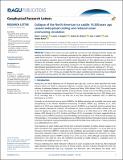Files in this item
Collapse of the North American ice saddle 14,500 years ago caused widespread cooling and reduced ocean overturning circulation
Item metadata
| dc.contributor.author | Ivanovic, Ruza F. | |
| dc.contributor.author | Gregoire, Lauren J. | |
| dc.contributor.author | Wickert, Andrew D. | |
| dc.contributor.author | Valdes, Paul J. | |
| dc.contributor.author | Burke, Andrea | |
| dc.date.accessioned | 2017-01-10T15:30:10Z | |
| dc.date.available | 2017-01-10T15:30:10Z | |
| dc.date.issued | 2017-01-16 | |
| dc.identifier | 248480794 | |
| dc.identifier | 1cca33c6-6e5b-42ea-ab50-b9026e5067c6 | |
| dc.identifier | 85009186310 | |
| dc.identifier | 000393954900045 | |
| dc.identifier.citation | Ivanovic , R F , Gregoire , L J , Wickert , A D , Valdes , P J & Burke , A 2017 , ' Collapse of the North American ice saddle 14,500 years ago caused widespread cooling and reduced ocean overturning circulation ' , Geophysical Research Letters , vol. 44 , no. 1 , pp. 383-392 . https://doi.org/10.1002/2016GL071849 | en |
| dc.identifier.issn | 1944-8007 | |
| dc.identifier.other | ORCID: /0000-0002-3754-1498/work/64034547 | |
| dc.identifier.uri | https://hdl.handle.net/10023/10076 | |
| dc.description | RFI is funded by NERC grant #NE/K008536/1. Numerical climate model simulations made use of the N8 HPC Centre of Excellence (N8 consortium and EPSRC Grant #EP/K000225/1). | en |
| dc.description.abstract | Collapse of ice sheets can cause significant sea-level rise and widespread climate change. We examine the climatic response to meltwater generated by the collapse of the Cordilleran-Laurentide ice saddle (North America) ~14.5 thousand years ago (ka) using a high-resolution drainage model coupled to an ocean-atmosphere-vegetation general circulation model. Equivalent to 7.26 m global mean sea-level rise in 340 years, the meltwater caused a 6 sverdrup weakening of Atlantic Meridional Overturning Circulation (AMOC) and widespread Northern Hemisphere cooling of 1-5 °C. The greatest cooling is in the Atlantic-sector high latitudes during Boreal winter (by 5-10 °C), but there is also strong summer warming of 1-3 °C over eastern North America. Following recent suggestions that the saddle collapse was triggered by the Bølling warming event ~14.7-14.5 ka, we conclude that this robust submillennial mechanism may have initiated the end of the warming and/or the Older Dryas cooling through a forced AMOC weakening. | |
| dc.format.extent | 10 | |
| dc.format.extent | 6440618 | |
| dc.language.iso | eng | |
| dc.relation.ispartof | Geophysical Research Letters | en |
| dc.subject | AMOC | en |
| dc.subject | Ice sheet melt | en |
| dc.subject | Saddle collapse | en |
| dc.subject | Older Dryas | en |
| dc.subject | GE Environmental Sciences | en |
| dc.subject | NDAS | en |
| dc.subject | BDC | en |
| dc.subject | SDG 13 - Climate Action | en |
| dc.subject.lcc | GE | en |
| dc.title | Collapse of the North American ice saddle 14,500 years ago caused widespread cooling and reduced ocean overturning circulation | en |
| dc.type | Journal article | en |
| dc.contributor.sponsor | NERC | en |
| dc.contributor.institution | University of St Andrews. School of Earth & Environmental Sciences | en |
| dc.contributor.institution | University of St Andrews. St Andrews Isotope Geochemistry | en |
| dc.contributor.institution | University of St Andrews. Earth and Environmental Sciences | en |
| dc.identifier.doi | https://doi.org/10.1002/2016GL071849 | |
| dc.description.status | Peer reviewed | en |
| dc.identifier.grantnumber | NE/M004619/1 | en |
This item appears in the following Collection(s)
Items in the St Andrews Research Repository are protected by copyright, with all rights reserved, unless otherwise indicated.

